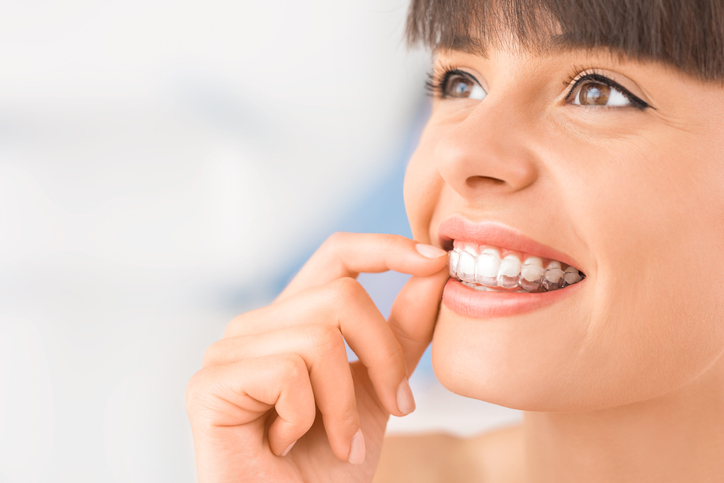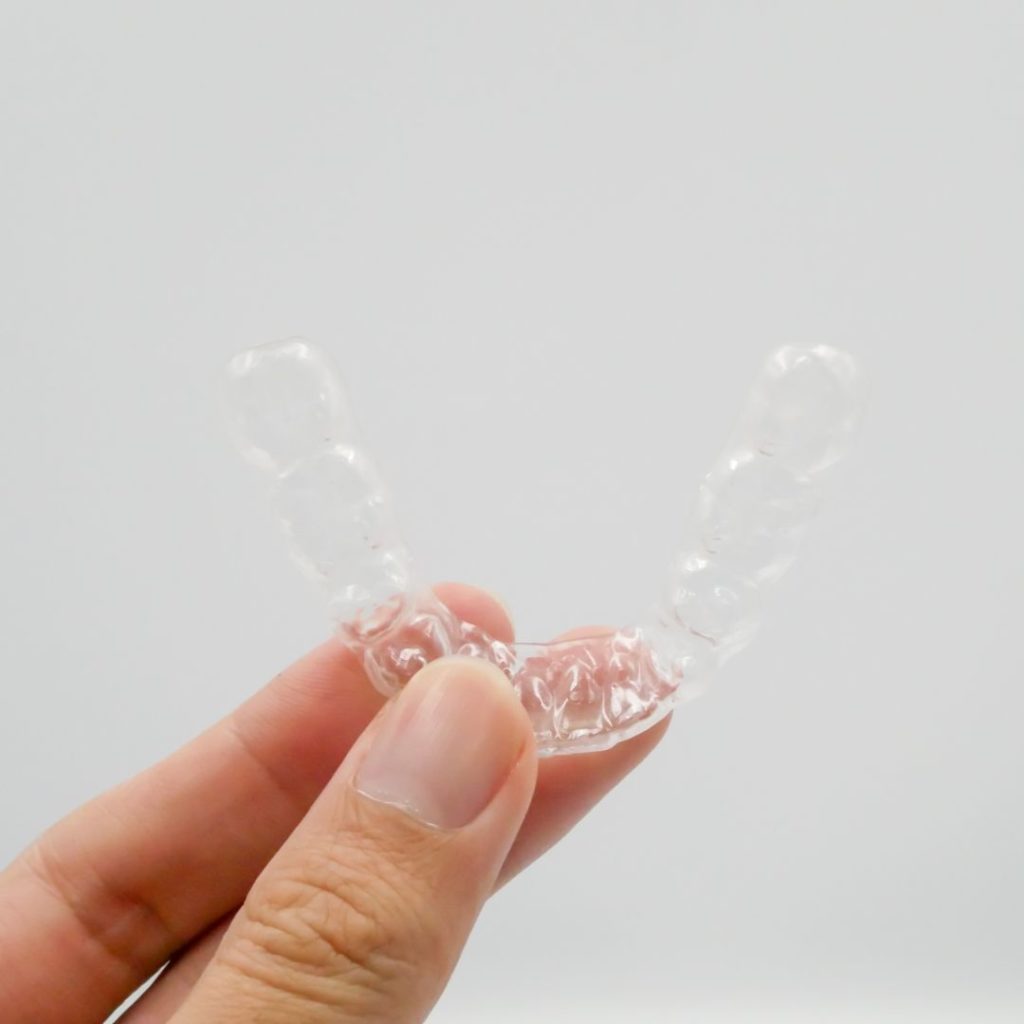Blog
When is it Time to Straighten Teeth?

There are so many ways to straighten teeth today and just as many reasons to attend to tooth alignment. The question isn’t whether or not to straighten teeth, but whether or not this process may be better at any specific stage. Generally, dentists begin to observe alignment and bite when children are 7 to 10 years old. Early orthodontic intervention may be ideal in certain situations, but today’s dental technologies make it possible to straighten teeth at any age. While teeth can be straightened any time a person so desires, there are some situations when timing is just right.
Aesthetic Teeth Straightening
Whenever crooked, crowded teeth degrade the confidence a person feels about their appearance, it is a good time to find the right straightening method. If you don’t feel your best in social or professional situations, if you cover your mouth when you laugh, then it’s time to view teeth-straightening as a worthwhile investment.
An upcoming event is often the catalyst that leads people to straighten their teeth. This could be a wedding, a new job, or starting a business. Any transition in life can make us feel both excited and vulnerable. Harnessing the power of a great smile can help.
Functional Teeth Straightening
There are both cosmetic and functional benefits achieved with teeth-straightening treatment. It may be time to undergo treatment when you want to:
- Have a smile makeover of any kind. Dentists often look at the alignment of teeth and how this will affect restorations like crowns or veneers.
- Resolve chronic headaches. Studies suggest that, when teeth do not fit well together, the joints and muscles of the jaw have to work harder. The stress on these structures then expands to stress on the muscles of the face, neck, and head. Straightening teeth to fit well reduces this stress.
- Improve oral health. Teeth that are crooked, overlapping, or spaced far apart are all difficult to clean well. Oral health can suffer when small nooks and crannies harbor plaque and bacteria. With straighter teeth, brushing and flossing become much more effective and oral health can improve significantly.
Is Now Your Time?
Now is typically the best time to take care of ourselves. If your smile and oral health could use some care, come talk to us about the benefits of Invisalign. Call (703)-935-2879 to schedule an appointment in our Burke, VA office.
Posted on December 6th, 2019
Bridges 101

A large gap in the smile is not good for your look. Did you know that a large gap in between any teeth, even those at the back of the mouth, could also degrade your smile? The mouth is not built for gaps. Teeth are made to butt-up to one another to achieve optimal physical appearance, chewing function, and speech. A smile with gaps is a smile that needs help. Here, we discuss how bridging the gap works.
What is Dental Bridge Treatment?
Dental bridges literally do bridge the gap between two teeth. There are three common bridges that dentists use to achieve this. They include:
- A traditional fixed bridge. Traditional bridges are used when a gap exists between two teeth. This type of bridge anchors to the neighboring teeth using dental crowns. The artificial tooth is suspended on the gums by these crowns.
- The cantilever bridge. This type of bridge is sometimes used when there is only one neighboring tooth next to a gap. The cantilever bridge has one crown, which anchors to that neighboring tooth. The false tooth is bonded to the crown to hold it in place.
- The Maryland bridge. This type of crown is not used as frequently today as it used to be due to advances in dental technology. The Maryland bridge does not use dental crowns to secure an artificial tooth, it uses metal wings that wrap discretely around neighboring teeth.
Bridges, Dentures, and Implants: What’s the Difference?
With so many dental techniques available today, it can be challenging to know which is right for you. At the same time, it is important to differentiate between various treatments to ensure you get the long-term results you deserve.
Dental bridges and dental implants are “fixed” types of restorations. they are intended to stay in place for many years. Dentures, on the other hand, are removable. The artificial teeth of a denture are not bonded or attached to other teeth in any way. Dental implants are root replacements, not tooth replacements. Situated in the jawbone in a minor surgical procedure, dental implants are intended as a new foundation for artificial teeth, such as crowns and bridges and, yes, dentures.
A dental bridge are an affordable option that provides good stability for chewing and speaking. This restoration can last 10 to 15 years with good care but may eventually need to be replaced due to wear and tear.
Is your smile in need of restoration? We can help. Contact our Burke office at (703)-935-2879 to schedule a visit with Dr. Price.
Posted on December 6th, 2019
Are You Clear on the Benefits of Flossing?

We know from years of research and clinical data that oral health is not complicated. There is no secret method of keeping teeth and gums healthy. All it takes is a consistent hygiene routine. With consistent brushing every morning and night (two full minutes) and flossing once a day, it’s possible to avoid a number of unnecessary problems. Here, we point out a few clear benefits of a daily flossing habit.
- Flossing makes your mouth feel cleaner.
Brushing your teeth removes most of the plaque and debris that accumulate but not all of it. Flossing removes the debris that collects in between teeth and right beneath the gums. When gunk is removed from these hard-to-reach places, the mouth will feel ultra-clean because it is.
- Flossing reduces the chances of gum disease and other problems.
Most people realize that flossing is their way to better gum health. On the contrary, when flossing is neglected, the gums become weak. Weak gums pull away from teeth. Where the fit between gums and enamel is loose, there is a chance of cavities forming. Because the area of the tooth exposed by weak gums is close to the root, there is a chance that the root area could become infected. This would need to be treated with root canal therapy.
- And still bigger problems.
Studies have linked poor oral health and gum disease, in particular, with several potentially serious health conditions. Gum disease is a bacteria problem. The purpose of flossing is to remove the bacteria that naturally colonize between teeth at the gum line. If bacteria accumulate, they deposit toxic chemicals into the mouth. These can lead to bad breath at the very least, severe gum disease and, at worst, can contribute to diabetes, cardiovascular problems, and more.
- Flossing can reduce the risk of discoloration.
Some of the stains that develop on teeth are localized at the inner corners where teeth meet. Stains can also occur along the gum line where plaque and tartar can build up. If nothing else, people may be motivated to floss to keep their smile as cosmetically pleasing as possible.
Flossing doesn’t have to be an unpleasant chore. The task takes less than five minutes to perform. That’s five minutes a day for a lifetime of healthy benefits. If string floss isn’t your thing, talk to your dentist about options such as a Water Pik or flossing tool.
Let us help you manage your oral health. Call our Burke office to schedule a checkup and cleaning.
Posted on November 18th, 2019
Are all Invisible Aligners the Same?

Not very long ago, the only path to a straight smile was through orthodontia. Even with changes to profile and materials, braces were pretty bulky. The brackets and wires patients were required to wear at all times overpowered the mouth both physically and cosmetically. No one really loved this but the outcome was worth the cost. It still is, actually, but we now have choices in how we straighten our teeth. The choice that many people make is to do so with invisible aligners.
Invisalign, the first of this kind of treatment, was developed in 1997. That’s a long time to be around! Dentists around the world still use this system with great success. The outcome of treatment is achieved by wearing custom-made aligners 22 hours a day. Though aligners can be removed, they shouldn’t be left out for too long. Patients are advised to take them out for meals and for brushing and flossing. Occasionally, they may be taken out for pictures or other special circumstances.
In light of the strong demand for convenient, discreet treatment, several other invisible aligner startups have recently emerged. SmileClubDirect is one of the most well-known. This type of system seems even more convenient and cost-effective because it cuts out the “middle-man” and puts orthodontic care in the hands of the patient through mail-order services. Seeing that the middle man in this scenario is the dentist, elimination may not be the best thing for the patient.
Invisalign Details
Invisalign’s RealSelf “Worth It” rating is over 90% with thousands of patients having undergone this treatment. The duration of care may range from as little as 6 months to a year and a half. What sets Invisalign apart from other systems is the degree of expert involvement in both the planning and active phases of treatment. This involvement of a trained dentist allows patients to address mild to complex issues including crowding, overlapping, gaps, and bite issues.
One of the important details about Invisalign that is directly related to results is the fact that this system goes beyond plastic aligners. In many cases, attachments are also worn. These transparent handles are affixed to teeth in a specific way that gets gripped by the aligners to achieve more complex movements. Dentists report that Invisalign attachments achieve much more than aligners could on their own.
Direct-to-Consumer Aligners
Aligners like those that are offered by SmileDirectClub have a RealSelf rating of about 57%. The average course of treatment lasts 6 months. Millions of dollars have been made by direct-to-consumer companies, even though patients have no meaningful contact with a dental professional. According to some people (we could hardly call them patients) self-treated with SmileDirectClub aligners, the lack of interaction made them wonder if anyone was overseeing their treatment at all. Some clients reported having a difficult time managing their care without a clear point-person to speak with about questions or concerns.
These concerns are more like complaints. What is concerning to dental professionals about direct-to-consumer aligners is that no x-rays are taken before treatment begins. Clients are asked only to submit photos to receive their prescribed aligners. Without x-rays, there is no way to know if the client has gum disease, impacted teeth, or root issues that could affect the outcome of treatment. Some dentists report seeing patients who self-treated with this type of aligner system only to find that, while their smile looks better, the teeth at the back of their mouth no longer meet.
The bottom line about aligners is that they are a big deal. Moving teeth is a big deal. When done correctly, teeth-straightening can improve function, hygiene, and appearance. When done incorrectly, teeth-straightening can create bite and joint problems that then require corrective treatment.
Choose Invisalign for your healthiest smile. Choose Dr. Stephen Price because he is Burke’s Premier Invisalign Provider.
Posted on November 18th, 2019
Gum Disease Can Harm Your Heart: Is it True?

Gum disease may be one of the most prevalent dental problems adults face, but that doesn’t mean everyone knows just how much they need to work on preventing inflammation and infection in their mouth. Statistics indicate that approximately 70% of tooth loss in adulthood is related to gum disease. More startling than that, even more adults (about 80%) have gum disease and don’t know it. If you’re wondering, gums that bleed when you brush and floss indicate inflammation. If your gums are puffy and red, bleed, and you have persistent bad breath, you can now count yourself as part of the 20% who are aware of their gum disease.
Knowing about gum disease is not enough. It is also necessary to understand why gum disease is a big deal and why we want to prevent it or treat it right away. One of the common theories is that gum disease is bad for the heart. Here, we dive into this concept to increase the awareness that all adults need to have.
What is Gum Disease?
Gum disease, gingivitis, and periodontitis or periodontal disease are all sides of the same coin. Each is a variation of inflammation and infection that affects the soft tissue that holds teeth in place. The progressive deterioration of the gums begins with an invisible film we call plaque. At first, plaque is soft. In time, it hardens as tartar against enamel. Both plaque and tartar are filled with bacteria. The microorganisms that live in the biofilm emit toxins that degrade both teeth and gum tissue. Weakened gum tissue pulls away from the teeth and allows bacteria to hide beneath the gum line, where extensive damage may be done.
What does This Have to Do with the Heart?
You may have heard the term “hardening of the arteries.” The condition doctors call atherosclerosis is a contributing factor to hypertension, stroke, and heart attack. It is also related to plaque. Atherosclerosis begins when sticky deposits of fat, cholesterol, and other debris become stuck in parts of various veins. The veins then become narrow and less capable of delivering oxygenated blood through the body. Studies have found that the plaque that forms in the blood vessels and arteries contains the same bacteria that are present in inflamed and infected gums. Scientists believe that these microorganisms naturally travel from the mouth into the bloodstream, where they then stick to the walls of important vessels.
Gum Disease Prevention and Treatment
The good news about gum disease is that it is one of the easiest disease processes to prevent and treat. You can start today by flossing your teeth. This habit should continue daily along with brushing teeth morning and night. If you notice redness or puffiness in your gums, schedule a visit with your Burke dentist. A thorough dental exam allows us to identify areas of inflammation and potential infection. We can measure the depth of pockets around teeth, if they exist, and discuss how to close them with proper treatment and home care.
Protect your gums, protect your heart. Schedule your visit with Dr. Price at (703)-935-2879.
Posted on October 30th, 2019
Habits to Carry You Through Halloween Temptations

Some people love the spookiness of Halloween; the decorations and haunted houses galore. More popular than that, even, is the vast selection of holiday treats trick-or-treaters receive in a matter of just a few hours. Even the treat-givers are often tempted to set a few goodies aside for themselves as they enjoy the revelry. Regardless of how much Halloween loot you and your family get this year, know that there are easy ways to have your “cake” and eat it, too. Here, we discuss a few strategies to prevent unnecessary tooth damage during the coming festivities.
- Time the treats. For yourself or children, candy can be a dangerous treat if not handled carefully. Timing can make a huge impact on the effects of sugary delectables on teeth. Dentists suggest that a few pieces of candy be given after a meal vs. as a random snack. Doing this limits the frequency of exposure to sugar.
- Eat this, not that. It isn’t that some treats must be avoided altogether, but some varieties are better when limited. These include sugary gum, hard candies that dissolve slowly, and sticky candy like caramel or taffy.
- Rinse and repeat. While it isn’t always possible to brush after snacks and meals, one can easily reach for water to dilute sugar residue in the mouth. After consuming candy or other sugary items, a quick rinse with water can wash some of the sugar down so it does not sit on enamel. Even better than simply rinsing, we suggest drinking plenty of water throughout the day when candies are around. This is an excellent alternative to sugary sodas and other beverages.
- Be good about brushing. Regular brushing is always an important aspect of ongoing oral health. When there is a stronger temptation to consume sugar, oral care becomes even more critical to cavity prevention. Brush morning and night for a full two minutes. It’s that simple!
Halloween is a fun time of year that we look forward to as much as our patients do. It’s also a great time to schedule routine checkups and cleanings for the whole family. To make your appointment in our Burke office, call (703)-935-2879.
Posted on October 15th, 2019
Taking Care of Invisalign Aligners is a Breeze

Braces may have an important role in a person’s long-term dental health, not to mention their appearance and confidence, but that doesn’t mean any patient is particularly excited about sporting a mouthful of metal. We meet a lot of people who express an interest in straightening teeth without braces. As a premier Invisalign provider in Northern Virginia, Dr. Price has had the pleasure of helping many of them do just that.
Invisalign is an excellent treatment option for anyone who wants to improve their smile. However, no treatment is without some degree of commitment. With Invisalign, this commitment revolves partly around the care of aligner trays. Keeping aligners looking good, feeling good, and smelling good doesn’t have to be a chore. Some simple strategies include:
- Brush them. Aligners are removed when you eat and when you brush and floss your teeth. After brushing your teeth, use your toothbrush to very gently brush the inside and outside of your aligners. This removes bacteria that could become plaque on the devices. Because aligners can be scratched, a very light touch must be used when cleaning them.
- Rinse them. You may not always be in a place where you can brush your aligners before inserting them. Maybe you’ve just finished a nice meal out with family or friends and you don’t carry a toothbrush with you at all times. Maybe the idea of brushing your teeth in public is unappealing. That’s ok. Before inserting your aligners, rinse them with lukewarm water. While you’re at it, also swish some water around in your mouth, trying to get in between teeth. This process takes about one minute and goes a long way to prevent the accumulation of bacteria.
- Remember to floss. Brushing is great and flossing is, too. To skip flossing is like brushing only half of your mouth. You wouldn’t do that, now, would you? Flossing after as many meals as possible (or rinsing your mouth) dislodges debris that could attract bacteria where they don’t belong.
We love talking about Invisalign! To learn more about this system and how it can work for you, schedule a consultation in our Burke office at (703)-935-2879
Posted on September 30th, 2019
Dentures Don’t Have to Be a Pain

Years ago, when dentures were in their early developmental stages, this method of tooth replacement was often observed as a last resort. People would only get dentures when their natural teeth were lost or needed to be removed due to dental disease. At that time, the dentures that were available rarely fit as well as they needed to, which then meant that they were uncomfortable and hardly capable of chewing a wide variety of foods. Today, dentures are made so well that they are nearly indistinguishable from natural teeth.
As far as we’ve come in resolving the issues that were the norm for early denture wearers, these dental devices still have somewhat of a bad rap. Perhaps one reason this happens is that people believe that dentures have become so good these days that they should never slip or cause discomfort in any way. Unfortunately, this isn’t true. Sometimes, dentures can feel a little less-than-perfect. Here, we suggest a few tips for managing the fit and stability of your full dentures.
Getting Adjusted
Often, it is right after a person receives dentures for the first time when they experience new and potentially unpleasant sensations. It can take some time to adapt to having a row of acrylic teeth sitting over the gums. To manage this adjustment phase, try:
- Rinsing the mouth with warm salt water a few times a day. This reduces inflammation.
- Applying a topical analgesic such as a teething cream to the gums to relieve soreness.
- Massaging the gums gently, maybe with a warm cloth, to increase circulation to sore tissue.
- Using a denture adhesive to reduce any slippage that may occur while dentures are worn.
The adjustment period for new dentures is typically limited to about two weeks. If discomfort or slipping continues beyond that time frame, contact your dentist for assistance.
Natural Changes Could Lead to Discomfort
When there are no natural teeth in the mouth, the body naturally breaks down the bone that once supported them. These changes are typically most substantial in the first 18 months after a full denture is made. This is why dentures may need to be adjusted more frequently in the first 2 years of wearing dentures. After that time, the rate of bone deterioration slows down but it does not stop. Periodic relining of the dentures is necessary to keep up with these natural changes.
Relining due to bone resorption may be less of a necessity if you choose to support your dentures with dental implants. The process may take slightly longer but the results of this hybrid treatment can last decades.
Learn more about denture treatment by calling our Burke office at (703)-935-2879, where we can schedule your consultation with Dr. Price.
Posted on September 15th, 2019
How Long Does Invisalign Treatment Take?

Options for straightening teeth have expanded over time. First, we had braces with brackets that wrapped fully around individual teeth. Then, brackets got downsized and bonded to the front surface only. In time, manufacturers discovered that metal brackets and wires were not the only option for correcting misalignment and bite issues. Clear braces became a common method appreciated by patients who wanted a more discreet treatment. When Invisalign was developed, the entire game changed.
Invisalign was the first teeth-straightening treatment that did not involve bonding brackets onto teeth. Not only are there no brackets, but there are also no wires strung across the smile. Invisalign is still the most well-known and most popular of the handful of aligner methods that have been created. As discreet and efficient as this system is, patients still like to know how long they will have to wear aligners. We’ll discuss that here.
How Invisalign Works
To understand how long Invisalign treatment will take, we have to look at how the method works. Invisalign straightens teeth with aligners that look like an average mouth guard. A series of aligners are made using sophisticated animation software. First, a model of the patient’s mouth is sent to the Invisalign lab. From that model, an animation is created to predict and plan each movement of various teeth in a progressive manner. Then, aligners are created in a way that will apply gentle, consistent force to those teeth. By switching aligners every two weeks, the patient achieves the correction needed to bring out the best in their smile.
Factors that Affect Timing
On average, a course of Invisalign treatment lasts about 12 months. However, some patients take less time and some take more. This depends on factors such as:
- The extent of misalignment. When teeth are only slightly crooked or crowded, treatment may take no more than a few months, followed by a retainer, of course. More severe alignment issues, such as an overbite, may require the full 12 months or longer.
- Aligner wear. Braces are a “set-it-and-forget-it” kind of treatment. Invisalign requires more thought and commitment. When aligners are removed for meals, for instance, it is necessary to insert them right away. Leaving aligners out often or for prolonged periods means teeth are not being pushed into their rightful position, which means it will take longer to see results.
- Follow up. Invisalign patients come into the office about every six weeks. These appointments are necessary to check progress and make adjustments as needed to stay on a timely track. Postponing appointments could mean prolonging treatment.
The best way to know how long Invisalign treatment would take for you is to consult with an experienced provider. To schedule a visit with Dr. Price, call our Burke, VA office at (703)-935-2879.
Posted on August 30th, 2019
Teeth Shifting? It’s Not Just a Teenage Problem!

As a premier Invisalign provider in Northern Virginia, Dr. Price works with patients of all ages to correct alignment issues. Quite a few who come to our office mention that their misalignment concerns only recently began. Teeth may shift at any time in life, which can come as a surprise. While the ultimate goal is to address the situation, many people are interested to know why their teeth have moved out of optimal position. The problem may stem from one of several factors.
Age
Throughout life, the jaw and facial bones may change somewhat. This can affect how teeth fit in the mandible. In particular, the lower front teeth are inclined to sit behind the upper front teeth. To maintain this, the lower teeth may crowd together, leading to turning or even overlap depending on the extent of shifting.
Bruxism
Bruxism is the term we use to describe teeth-grinding and jaw-clenching behaviors. Many people engage in grinding and clenching when they sleep so are unaware of the stress their jaw and teeth are under. The pressure that is exerted onto teeth by bruxism can cause shifting as well as several other problems. A nightguard can be custom-made to decrease the force on teeth.
Tooth Loss
In childhood, tooth loss is necessary for permanent teeth to grow in. Tooth loss as an adult can be problematic. If a tooth falls out, is injured, or needs to be extracted, our priority is to replace structure as quickly as possible. Teeth butt-up to one another for support. The space that is created by tooth loss depletes the support of surrounding teeth, inviting them to shift.
Whatever the cause, at whatever age, misaligned teeth can create unnecessary self-consciousness. As troubling as a crooked smile can be, this problem is one that can be easily corrected. Invisalign is a reliable solution that is appropriate for many people. In some cases, it may not even be necessary to straighten a tooth or teeth. Veneers can be made to cover a turned tooth, fill gaps, and generally enhance the appearance of the smile.
To learn more about how we can help you correct shifting teeth, call our Burke office at (703)-935-2879.
Posted on August 15th, 2019

